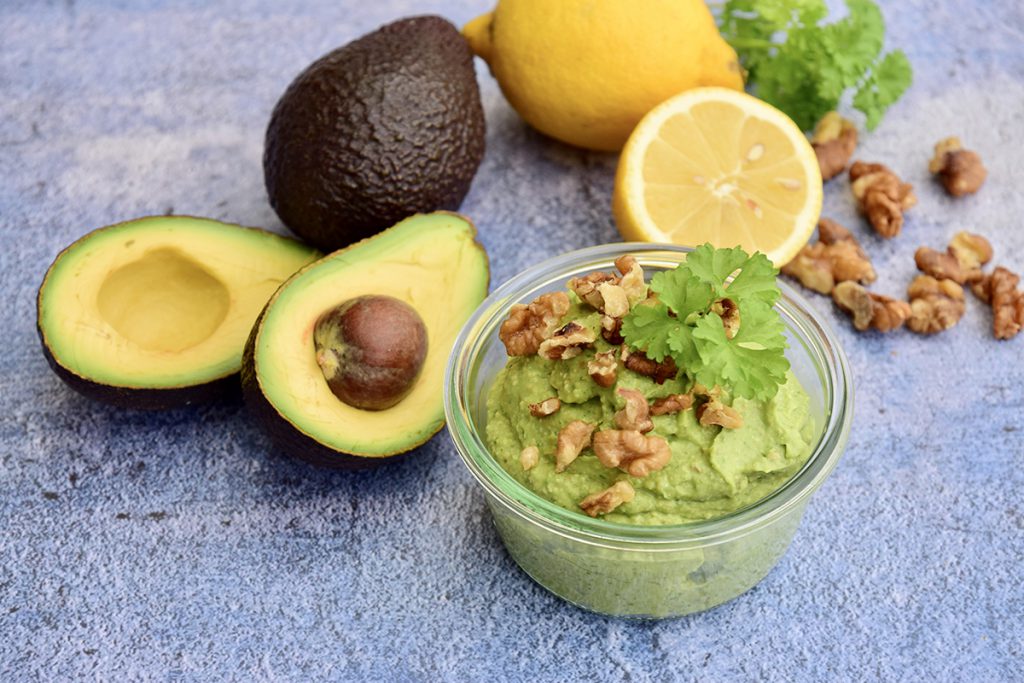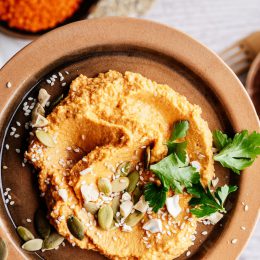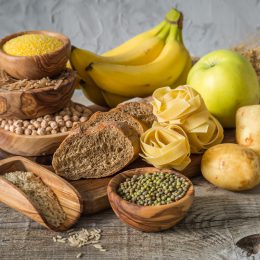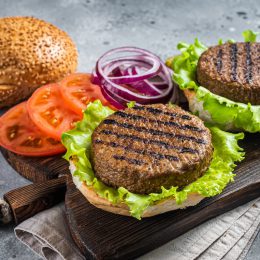The 5 Healthiest High-Fat Foods, According to Dietitians
Gone are the days of trimming the fat! Kick low-fat foods to the curb and embrace these nutritious and satisfying foods.

You’re forgiven if you have a complicated relationship with fat. Throughout the ‘90s and into the 2000s (so a good chunk of your adulthood) the message was “eat as little fat as possible.”
Store shelves were lined with low-fat and fat-free foods. Omelettes were made with egg whites only.
Then, we were told some fats were okay—good even! And now, with low-carb and “keto” diets everywhere, it seems like anything goes.
It’s true, fat is not the nutritional bogeyman you may have once believed.
“Dietary fat is important for a number of reasons including supporting cellular function, protecting your organs and providing the energy you need for daily function,” says Angel Planells M.S., R.D.N. She’s a Seattle-based registered dietitian nutritionist and national media spokesperson for the Academy of Nutrition & Dietetics.
We also need fat to absorb fat-soluble vitamins (A, D, E, and K), and to make certain hormones. Plus, adding high-fat foods to your diet helps you feel less hungry and adds flavor to your meals and snacks.
Healthy eating and fitness go together! SilverSneakers classes and events are happening right now at participating gyms, online through SilverSneakers LIVE, and at community centers near you. Activate your free online account to get started.
Here are 5 fatty foods with health benefits that will help you overcome your fear of fat.
Healthy High-Fat Food #1: Walnuts
Nuts in general are an excellent source of healthy fats. But walnuts also boast a plant-based omega-3 fat called ALA, which is good news for your heart health.
According to a recent review published in Advances in Nutrition, higher intake of ALA was linked to a 10 percent lower risk of heart disease. And walnuts specifically helped lower blood cholesterol levels.
“Eating plant-based omega-3 fats in place of less healthy foods is a win for your heart health,” says Katie Dodd, M.S., R.D.N., a geriatric dietitian practicing in Medford, Oregon.
Dodd adds that for people who don’t eat much (if any) seafood, nuts and seeds like walnuts, chia seeds and flax can help fill the omega-3 void. And it doesn’t take much—just a 1/2 ounce serving of walnuts provides the daily recommended amount of ALA.
Extra credit: Walnuts are also an excellent source of manganese, a mineral involved in metabolism, bone formation, immune function, and more.
Sneak more in: Enjoy a small handful of walnuts as a healthy snack. Chop and toss them on oatmeal, salads and roasted vegetables. Add them to baked goods and homemade pesto.
Healthy High-Fat Food #2: Avocado
This fatty fruit is the poster child for “good” fat. It’s made up mostly of monounsaturated fats. Planells explains that these fats can protect your heart by maintaining levels of HDL cholesterol (“the good kind”) while reducing your LDL cholesterol (“the bad kind”).
The guac star also features antioxidants, which research in the Journal of Nutrition shows might help reduce oxidized LDL, a particularly harmful type of cholesterol.
All of this adds up to good news for heart health. In a large population study, people who ate at least 2 servings of avocado a week were 16% less likely to develop heart disease than those who ate little or no avocado. The results were published in the Journal of the American Heart Association.
Replacing foods high in saturated fat—like butter, cheese or processed meats—with avocado was particularly beneficial.
Extra Credit: Each one-half of an avocado has a lofty 6 to 7 grams of fiber. This is about a third of what women over 50 need each day.
“This fiber can keep you feeling full for longer and can improve cholesterol and blood sugar levels,” notes Dodd.
Sneak more in: Guacamole and avocado toast are obvious (and delicious) ways to eat more avocado, but it has lots of other versatile uses. Its creamy texture makes it a great substitute for other fats like butter or mayonnaise. For example, try making chicken salad with mashed avocado.
Since it has a mild flavor, it works in sweet dishes, too—try blending it into a smoothie. (Find a recipe for Lemon Mango Mint Avocado Smoothie here.) You can even make pudding, ice cream and “buttercream” frosting with avocado (the avocado replaces the butter).
Healthy High-Fat Food #3: Sardines
Most animal foods are high in saturated fat, so leaner is better. But not fish. Seafood is high in healthy omega-3 fatty acids, so cast your line for fattier options, like canned sardines.
Omega-3 boasts many health benefits, and it is an essential fat. This means our bodies cannot make it, so we have to get it from foods.
“The research shows that higher intakes of these omega-3 fats are associated with lower risk of premature death by decreasing your chances for heart disease, cancer, Alzheimer’s, and more,” Planells says.
The American Heart Association recommends eating one to two servings of fish a week to protect heart health. Beyond sardines, you can reel-in omega-3s from salmon, herring, mackerel, black cod and tuna.
Extra Credit: Since sardines are eaten bones and all, they are an excellent source of calcium (a 3-oz serving has more calcium than a cup of milk). Plus, they are a natural source of vitamin D which works with calcium to build strong bones.
Sneak more in: Sardines are a great addition to sandwiches, salads, and as a topper for crackers or bread. If eating them whole weirds you out, you can sneak them into fish cakes or pasta dishes or add them to tuna salad for an extra dose of omega-3s.
Healthy High-Fat Food #4: Full-Fat Yogurt
The 2020-2025 Dietary Guidelines for Americans still recommend limiting saturated fat. This type of fat is high in animal products like meat and dairy.
That said, it’s not necessary—or beneficial—to remove all the saturated fat from your diet. Full fat dairy, like yogurt, may have some benefits.
Subscribe to our newsletter
It's quick and easy. You could be one of the 13 million people who are eligible.
Already a member? Click to discover our 15,000+ participating locations.
Follow Us
A recent study in PLOS Medicine looked at the link between dairy fat and heart disease. It found that people who ate more dairy fat had a surprisingly lower risk of heart disease than those who ate less.
Researchers aren’t sure yet why dairy fat might be protective. Dairy has specific kinds of saturated fats that may be less harmful than the types in red meat, for example. Or it could be that other nutrients in dairy, like calcium and vitamin B12, are protective.
Either way, the research seems to suggest that you may not need to rely on low-fat or fat-free dairy alone to keep your heart healthy.
“From a personal perspective,” adds Planells, “consuming regular fat yogurt can make a person feel more satisfied.”
Extra credit: Yogurt is a fermented food, making it a good source of probiotics. Planells says these good bacteria can improve your gut health and even improve heart health.
Sneak more in: Single portion yogurt cups are great for a quick breakfast or snack. Start with plain yogurt and add your own toppings to minimize added sugars.
Blend yogurt into smoothies or use it as a base for creamy dressings. Thick Greek-style yogurt is a good stand-in for sour cream.
Healthy High-Fat Food #5: Tahini
Popular in Middle East kitchens, tahini is made by blending sesame seeds into a creamy paste. Roughly 80 percent of the fat in tahini comes from healthy unsaturated fatty acids. One of them is linoleic acid, an essential omega-6 fat that is important for cell function.
Dodd explains that this fat is considered essential because our bodies can’t make it. We must get some from our diets each day for good health. Tahini is also a good source of monounsaturated fats.
Extra credit: Sesame seeds contain calcium and phosphorus, two minerals that help maintain strong bones. The creamy spread is also a source of sesamin. Early research suggests this unique compound might have some potential cancer-fighting powers, though research is preliminary at this point.
Sneak more in: You can use tahini where you might use other nut butters—drizzle it on oatmeal or fresh fruit, top toast with it, add it to a PB&J, or blend it into a smoothie.
It’s also great in savory dishes like hummus or whisked into creamy sauces for salads, grain bowls or cooked chicken or fish.
Activate Your FREE SilverSneakers Online Account
Get hundreds of free SilverSneakers On-Demand videos and stay in touch with us by creating your free online account. You don’t have to be a SilverSneakers member to get on-demand workout videos, health and fitness tips from SilverSneakers, and more.
SilverSneakers members can go to thousands of nationwide gyms and fitness locations, plus take SilverSneakers LIVE online classes led by specially trained instructors and designed for all fitness levels and abilities – at no additional cost. If you have a Medicare Advantage plan, it may include SilverSneakers. Check your eligibility here.
Already a member? Get your SilverSneakers member ID, search for locations near you, and all the health and wellness resources you need by logging in to your online member account here.




